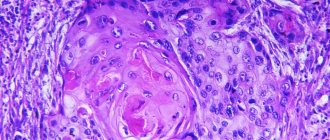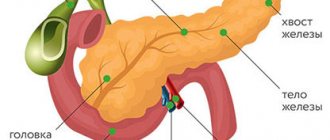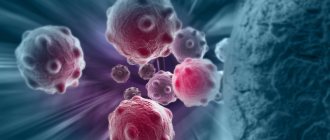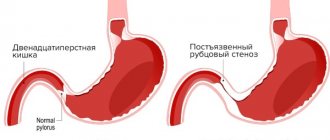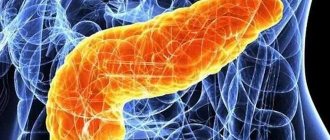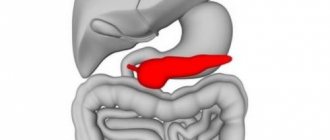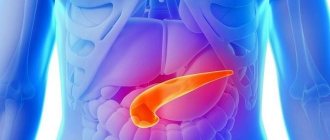Stage 4 of pancreatic cancer (PG) is the last, most unfavorable stage of the disease. It is characterized by further spread of the disease in the form of metastases to neighboring and distant organs. Due to the extremely unfavorable prognosis for life, treatment measures for pancreatic cancer in the last stage are aimed at improving well-being and increasing life expectancy by several months.
What is stage 4 pancreatic cancer?
The diagnosis of “stage 4 cancer” is made when the changed cells penetrate the blood and lymph flow, and the tumor spreads throughout the body. The severe phase of the disease occurs mainly at the age of 60 years and older. Statistics show that mortality from pancreatic cancer ranks 4th among all cancers; men over 50 years of age are more likely to suffer.
Before this phase, the pathology is not diagnosed for several reasons:
- The topography of the pancreas makes it inaccessible to palpation during a routine objective examination (it is located retroperitoneally).
- Due to the complex anatomical structure of iron, it plays a dual role: exocrine (digestive) and endocrine (hormonal).
The parenchyma of the pancreas consists of delicate glandular tissue, which is easily destroyed under the influence of external and internal unfavorable factors. The dead cells of the organ are not restored, and it gradually loses its functions. The initial stages of cancer development are either asymptomatic, or a patient with existing pancreatitis and diabetes mellitus may not pay attention to the change in his condition, considering it a manifestation of the underlying disease. They most often come to the doctor at the last stage of cancer, when the condition is serious and there are many complaints due to the impaired functioning of several organs.
Most often, the location of a severe tumor is the head of the pancreas.
Features of stage 4 cancer
A feature of stage 4 pancreatic cancer is the serious condition of the patient with a detailed clinical picture. There are symptoms of pathology of the digestive system and manifestations from other organs involved in the malignant process. At this stage, multiple metastases:
- invade nearby organs: stomach, liver, intestines, spleen,
- spread to distant bones, brain, lungs.
Cancer of the head of the pancreas always affects the liver. This is explained by topography and anatomical structure: the organ is located close to the gland, the common bile duct passes through the head of the pancreas and in most cases connects with the Wirsung canal into one common ampulla, flowing into the lumen of the small intestine through the papilla of Vater. With metastasis to the liver, the prognosis sharply worsens: the tumor quickly affects its entire parenchyma.
When the bile ducts are involved, obstructive jaundice develops. This occurs at the last stage of the disease, when there is an active process of growth and metastasis.
Enlarged lymph nodes are characteristic: they are painful, loose, and those that are accessible are easily palpated.
Due to the proximity of the intestine (the pancreas directly borders both the small and large intestines), its obstruction develops.
Metastases invade the peritoneum, spread to the spleen tissue, causing rapid development of liver failure with ascites (the presence of fluid in the abdominal cavity, sometimes up to 20 liters) and splenomegaly. Severe intoxication occurs, leading to a sharp disruption of the condition.
Signs of stage 4 of development
At this stage of the development of the disease, the patient experiences severe and painful signs of cancer. At the same time, the most frequently manifested symptoms of cancer at the fourth stage include:
- Cancer intoxication, which is characterized by very severe weakness, lack of performance and appetite, and weight loss. In this case, the patient’s body temperature may remain high for several days or even weeks.
- Continuous severe pain that intensifies when changing body position. A person feels relief only in the fetal position. The pain radiates to the lumbar region, shoulder girdle, chest and upper limbs.
- Disruption of the digestive system. The body is no longer able to digest the incoming nutrients, which causes bloating, nausea and sometimes vomiting. Nutrient deficiency leads to the development of anemia and vitamin deficiency.
- Increased size of the spleen, liver, lymph nodes.
- Development of thrombophlebitis.
- The skin and mucous membranes acquire a yellow tint, which indicates liver damage.
- The appearance of a cough with bloody sputum when metastases occur in the lungs.
If in the previous phases of the development of the disease the patient maintains motor activity, then at this stage the patient spends almost all the time in bed. This is due to a state of severe weakness. Changes also occur in the patient’s nervous system, which manifests itself in symptoms: aggressive and irritable behavior, and a state of depression.
Reasons for the transition of a tumor to a late stage
The main reason for the development of stage 4 cancer is late diagnosis. The disease is determined in the inoperable phase, which is explained by the latent period in its course: several weeks or even months pass from the onset of the first minor to severe manifestations. Because of this progression in the early stages, pancreatic cancer is called a silent killer.
As indicated, late detection is associated with the absence of symptoms, their inconsistency in the initial stages, or the patient’s inattention to his health: manifestations of the disease can be missed if a person suffers from diabetes, chronic pancreatitis with frequent exacerbations, gastritis, colitis or other pathology of the digestive system . Late contact with a specialist leads to the fact that only symptomatic therapy is prescribed due to the inability to influence the widespread process.
Signs of pathology
Why is it that people don't pay attention to the symptoms of pancreatic cancer? It's all about the lack of a clinical picture. When an oncological tumor is in the initial stages (1 or 2), a person may have minor manifestations of the disease, but few people pay attention to them.
This is due to a passive lifestyle, alcohol, smoking, poor diet, which is why periodic pain in the abdominal area surprises few people and does not make them wary. Stage 3 pancreatic cancer - already a critical diagnosis, characterized by the manifestation of a pronounced symptomatic picture, but still subject to treatment and prolongation of a person's life - provokes severe pain.
In cases where a person was previously diagnosed with pancreatitis, the signs of cancer are again ignored, the patient thinks that this is an aggravated inflammation of the liver. Symptoms of stage 4 pancreatic cancer:
- very severe pain;
- frequent attacks;
- increased pain at night;
- the intensity of the symptom increases if the person changes body position;
- yellow color of the skin and mucous membranes;
- sudden loss of body weight;
- refusal to eat;
- general weakness and drowsiness;
- increased fatigue;
- frequent attacks of nausea and vomiting.
At the last, 4th stage of cancer development, the tumor reaches a very large size. It begins to put pressure on the bile ducts, causing them to stop functioning normally, stagnation occurs, food cannot be digested, and the functioning of all organs of the gastrointestinal tract is disrupted.
The body, knowing that it cannot cope with food, begins to react to any food with vomiting and nausea, so a person develops an aversion to food. Rapid weight loss is explained by dysfunction of the pancreas, which cannot generate enzyme substances that are actively involved in the processing of carbohydrates, proteins and fats.
You can often hear a story about how a friend or relative suddenly died of pancreatic cancer, but this does not happen. Oncology of this organ develops gradually, and people do not suddenly die from such a disease. People simply do not pay attention to the first signs of pathology and seek medical help mainly only when doctors can no longer do anything.
How long do you live with stage 4 pancreatic cancer?
No specialist can say exactly how long a patient will live. Each patient with the last stage of pancreatic cancer lives for different periods of time and may die from complications. What matters is the level of spread of metastases and their number. If the liver is involved, death occurs within a few months. Intoxication and its severity also play a role.
The average life expectancy is 4−6 months. Inoperable patients live about 6 months. Only 5% of patients can survive more than a year after intensive treatment.
Acting:
- old age and male gender,
- intensity of intoxication,
- complex of anticancer therapy,
- quality of patient care.
The more severe the pathology, the faster it spreads.
1-2% of patients manage to live up to 5 years with stage 4 pancreatic cancer. If you agree to medical manipulations, the probability of prolonging life increases by 3−5%. Most patients die refusing the proposed treatment, and for those who decide to use chemotherapy for stage 4 pancreatic cancer, life is prolonged from 1 to 3 months. This is due to poor tumor growth control.
Features and description of the diagnosis
In most cases, as already mentioned, oncological pathologies of the pancreas are the result of advanced pancreatitis - severe damage to this organ associated with increased activity of digestive enzymes.
To correctly diagnose this disease, you need to know the mechanism of its occurrence. In its normal state, the gland produces digestive enzymes, which are then sent to the intestines for the final destruction of food debris. But suddenly a malfunction occurs - too many enzymes are produced. This may happen for the following reasons:
- in forty percent of cases this is what the body’s reaction to regular excessive consumption of alcoholic beverages looks like;
- the hereditary factor plays an important role;
- The quality of food consumed by a person is important: if it is excessively fatty, overcooked, spicy, more and more enzymes are required to digest it.
And here a very interesting process begins. The enzymes overwhelm the gland so much that they simply cannot leave it all at once. And if the pancreatic ducts are also blocked by gallstones, which happens quite often, the path to the intestines for many enzymes becomes insurmountable.
And then they begin to digest the cells of their progenitor gland. This process can go very quickly. At first, the cells simply become inflamed, which is how pancreatitis develops. Then they begin to die off. It is against the background of necrosis that pancreatic cancer can begin to develop - the appearance of a malignant tumor, which, as it grows, destroys the tissue of other organs, up to the brain.
Important! The further the disease progresses, the more likely it is to die.
The fourth stage of oncology is the last. Diagnosis of the disease is based on several principles :
- visual examination of the patient;
- clarification of hereditary factors;
- laboratory tests are carried out;
- ultrasound determines the size and location of the tumor;
- MRI allows for layer-by-layer scanning;
- biopsy using laparoscopy definitively establishes the nature of the malignant tumor and its type.
Signs and symptoms of stage four
The main clinical sign of stage 4 pancreatic cancer is pain. It can be constant, but intensifies at night due to frequent intense attacks or with sudden movements and bending of the body.
In 100% of cases, significant weight loss occurs due to impaired pancreatic secretion and decreased appetite. Since pancreatic cells undergo changes during cancer, they lose their functions and multiply intensively. As a result of their uncontrolled division, the tumor grows rapidly and increases in size. Even tissue that has not undergone cancerous changes is compressed by the growing tumor and ceases to function. Pancreatic juice ceases to be produced in the required quantities, incoming proteins, fats and carbohydrates are not broken down into simple components and are not absorbed. With a normal amount of food eaten, a person loses weight sharply. Due to severe intoxication with the decay products of the tumor and its foci, appetite also decreases, an aversion to various types of foods and dishes appears, and dyspeptic disorders - nausea, vomiting, diarrhea - dehydrate the body and contribute to even greater weight loss. The general condition sharply worsens, progressive general weakness, exhaustion, and sleep disturbance appear.
In 80% of patients, when the bile ducts are compressed by a growing tumor, obstructive jaundice develops - bile stops being released into the duodenum. The skin, mucous membranes, and sclera become yellow with a greenish tint. This is accompanied by painful itching, which intensifies at night. Multiple traces of excoriation (scratching) appear on the skin, which can become inflamed. There is no fever, a large painless gallbladder is detected by palpation (Courvoisier syndrome).
A feature of the last stage of cancer is multiple enlargement of regional and distant lymph nodes. In some of them, secondary tumor foci are found.
Pancreatitis and diabetes mellitus also occur, which further worsens the condition.
Early symptoms
The symptomatic picture of the disease is mild, blurred, which is often the reason for late detection of the disease.
In the initial stage, pancreatic cancer is curable if the patient contacts at the first minor signs of poor health. An early symptom is discomfort or mild abdominal pain without clear localization. In the future, it may bother the epigastrium, umbilical region and right hypochondrium. This is due to the location of the tumor in the head of the pancreas. If a malignant formation develops in the tail or body, unpleasant sensations may appear in the left hypochondrium, radiate to the back, or take on a girdling character.
Discomfort or pain increases after eating fried, fatty foods and alcohol. Smoking, smoked, salty foods, carbonated drinks, strong tea and coffee can also provoke their appearance.
In addition to unpleasant sensations, the following appear:
- nausea,
- unstable stool - constipation or diarrhea, especially after errors in diet,
- loss of appetite,
- damage to the esophagus - due to esophagitis, a burning sensation may appear behind the sternum,
- dysphagia - an unpleasant sensation behind the sternum and difficulty swallowing when the esophagus is damaged (there is a direct relationship between the degree of dysphagia and the stage of cancer),
- gradual weight loss,
- manifestations of asthenic syndrome - increasing unmotivated weakness not associated with physical activity or mental work, sleep disturbance, feeling of constant fatigue,
- dry mouth, thirst, polyuria with beginning endocrine dysfunction.
This condition can last for months, gradually worsening. But with timely consultation with a doctor at an early stage, the tumor can be cured.
Late signs
Late signs are a very poor condition of the patient with a predominant manifestation of the clinical picture of impaired functions of the affected organs (in addition to the pancreas itself). All symptoms that were not noticed by the patient at an early stage of the disease have extreme degrees of severity:
- Abdominal pain is constant, with intense attacks that occur at night and when changing body position, bending, or moving. Its localization may vary depending on the location of the tumor, its size and extent,
- uncontrolled weight loss, up to cachexia,
- jaundice due to compression of the common bile duct (common bile duct),
- nausea, vomiting, diarrhea,
- signs of severe intoxication - severe weakness, poor sleep, lack of appetite, aversion to food,
- enlargement of lymph nodes with changes in their structure. Sometimes the leg may swell when regional lymph nodes are involved,
- secondary diabetes mellitus, especially when the tumor is localized in the caudal part of the pancreas, where the bulk of the islets of Langerhans that produce hormones are located, thirst, polyuria, and constant dry mouth (hyperglycemia) appear.
Sometimes pancreatic cancer provokes increased production of insulin, which is accompanied by tremors of the limbs, general weakness, even loss of consciousness (hypoglycemia).
Signs of tumor metastasis
In addition to the parenchyma of the pancreas itself, the following are affected:
- The lymph nodes,
- nearby and distant organs due to cancer cells entering the blood, lymph, peritoneum and spreading throughout the body.
Organs in direct contact with the pancreas: duodenum, stomach, liver, intestines, spleen. Distant: lungs, kidneys, brain, bones.
If the respiratory system is affected, cough, chest pain, shortness of breath, and hemoptysis may occur.
When the kidneys are involved in the pathological process, difficulty urinating and changes in the urine appear.
If metastases have reached the brain, a variety of neurological symptoms may be observed depending on the area of the lesion:
- excruciating headaches,
- dizziness,
- impaired coordination of movements, voice, clarity of speech,
- loss of consciousness,
- mood swings.
All this indicates the presence of metastases in the brain.
Symptoms
Even at stage IV of the disease, when metastases affect not only the gland, but also neighboring organs, for example, the liver, the symptoms of this disease may not be very clearly expressed, which leads to a not very positive prognosis for treatment.
Usually the symptoms are expressed like this:
- especially after eating, the patient begins to experience nausea, which turns into vomiting;
- Periodic pain occurs to varying degrees; it can manifest itself in different places in the hypochondrium and abdominal cavity, depending on the location of the tumor;
- The patient is often bothered by diarrhea, which is debilitating;
- there is a feeling of fullness in the stomach;
- Cancer is often accompanied by yellowness and whiteness of the skin;
- the patient is worried about sweating, chills, general weakness and lack of appetite;
- the last stage is characterized by rapid weight loss.
At or near death, symptoms may become more complex:
- the pain becomes severe, and not paroxysmal, but unbearable and constant;
- when the brain is damaged, the head hurts severely, and hallucinations begin with loss of consciousness;
- blood appears in stool and urine;
- the temperature may rise sharply;
- Against this background, blood pressure may, on the contrary, drop.
Let's look at how people die with this diagnosis. The approach of death has several stages :
- preagonia is accompanied by a depressed physical state, not only pallor is indicated, but also a noticeable cyanosis of the skin;
- blood pressure drops very sharply;
- agony can last up to 3 hours: during this time, severe oxygen starvation occurs with a gradual cessation of breathing;
- clinical death is observed with cardiac arrest, some processes still occur in the body for a few minutes, then biological death occurs.
Late stage diagnosis
Due to the asymptomatic development of the tumor in the initial stages, pancreatic cancers are detected already in the final stages. Since the pancreas cannot be palpated during an objective examination due to its retroperitoneal location, the diagnosis is made taking into account:
- patient complaints,
- life history (it is found out whether there were any cases of cancer in close relatives) and illness,
- laboratory and functional examination methods.
Basic laboratory methods:
- general clinical blood tests (inflammation, anemia are detected) and urine,
- biochemical (diastase, bilirubin, transaminases, alkaline phosphatase, total protein and fractions),
- tumor markers (cancer antigens to pancreatic tissue are detected),
- stool analysis (coprogram).
Functional examination methods for detecting stage 4 pancreatic cancer:
- Ultrasound of internal organs: ultrasound is used to detect the presence, location and size of a tumor. It has a good review from doctors of all specialties who use it for diagnosis. This is the screening method that is used first. It is informative, convenient because it does not require special training, safe, fast and takes little time.
- CT, MRI - allow you to carry out layer-by-layer scanning of any organ and obtain an accurate three-dimensional image. MRI is a preferable method due to the lack of radiation exposure: it is based on the use of a magnetic field, it is possible to detect a tumor as small as 2 cm, enlarged lymph nodes and metastases. If the patient has contraindications, a CT scan is prescribed.
- Laparoscopy with biopsy for histological and cytological analysis is necessary to confirm the malignancy of the tumor and clarify the type of cancer. At stage 4, it is rarely performed; other, less traumatic methods (percutaneous) are used to take a biopsy.
Treatment methods for breast cancer at stage 4
In the late period, the tumor grows and becomes enormous in size, so the disease cannot be cured. You can only alleviate the condition and prolong life, since metastases in this phase of the disease cover other organs. Goal of treatment:
- reduce the size of education,
- stop its further spread.
To achieve the desired result, complex treatment is carried out:
- palliative surgery,
- chemotherapy,
- radial,
- targeted,
- symptomatic.
To reduce the tumor, part of the pancreas and affected organs are removed (Whipple operation). Thanks to surgical interventions, the patency of the intestines and common bile duct compressed by the neoplasm is restored.
Chemotherapy reduces the aggression of cancer cells. This is one of the effective methods: it stops or slows down tumor growth and metastasis to other organs. Cytostatic drugs are used that are unsafe for humans: they contain poisons and toxins. This technique allows the patient to live for several more months after the course.
Radiation therapy destroys the structural protein of cancer cells, causing the tumor to shrink. Exposure to highly active X-ray radiation causes the death of aggressive cells, which provides slight stabilization of the tumor.
Radiological therapy with the CyberKnife device is increasingly being used.
Narcotic analgesics are prescribed for pain relief. Symptomatic treatment for digestive dysfunction is also used.
Targeted therapy is a new technology that affects the tumor at the molecular level. It is prescribed to seriously ill patients in the absence of effect from other treatment methods. The idea is that the drug blocks the molecule responsible for the development of cancer cells. As a result, metastases completely disappear. The difference between this method is that the drugs used do not affect healthy tissue. Drugs used: Rituximab, Avastin, Imatinib.
Treatment
If the disease was detected already at stage 4, then treatment for pancreatic cancer can be exclusively supportive. In this case, the therapy used should pursue the following goals:
- reducing pain and improving the well-being of patients;
- normalization of the functionality of the digestive system;
- ensuring patient life expectancy.
Important information: Herbs for the treatment of pancreas
The main method of treating a tumor at the fourth stage of development is chemotherapy, which is aimed at inhibiting the growth of cancer cells and preventing their further spread throughout the body.
If the location of the tumor and the patient’s condition allow this, then chemotherapy is combined with surgery or the so-called Whipple operation, in which the head of the organ is removed and the stomach, gallbladder, duodenum and affected lymph nodes are resected.
If cancer cells have grown into blood vessels, then surgery is contraindicated. In some cases, surgery is allowed to improve digestion.
Will folk remedies help defeat a tumor?
A favorable prognosis is possible with early consultation with a specialist. According to statistics, 10% of patients come to the doctor when the tumor is still within the pancreas. It is for this group of patients that the prognosis becomes most favorable. In later stages, survival rates drop sharply.
It is not recommended to self-medicate and use traditional methods without consulting a specialist. Even if these are medicinal plants, any recipe from them must be agreed upon with an experienced herbalist after a preliminary consultation with an oncologist. Folk remedies, when properly prescribed and used, can only temporarily alleviate the condition, but cannot defeat the tumor.
Recently, the miraculous properties of the drug ASD-2 (Dorogov’s antiseptic stimulant of the second fraction) have often been mentioned. The annotation states that the medicine is a powerful adaptogen and has a radioprotective effect, eliminates pain and slows down the further development of the tumor. The author of the drug prescribed the drug to fight cancer in severe cases. It was stipulated that a mandatory condition for use is the supervision of a specialist. It is strictly not recommended to prescribe and use it on your own, since there are negative reviews about the use of the drug due to the deterioration of the general condition. Therefore, it is impossible to talk about its effectiveness and the fact that it really cures cancer.
The soda treatment method was developed by Professor I.P. Neumyvakin. He recommends taking sodium bicarbonate daily on an empty stomach according to a specific schedule. According to the patients themselves, with proper treatment it is possible to recover even from the fourth stage of cancer. But there are no statistics or evidence-based medicine studies that would confirm the effectiveness of such treatment.
Pain relief for the patient
In the later stages of the disease, the main symptom is severe pain. Symptomatic treatment is the use of analgesics.
Initially, they try drugs from the NSAID group: Ketanov, Ibuprofen, Naproxen. If there is no effect, opiates are prescribed (Tramadol, Promedol). Their main side effect is addiction, which is why you have to increase the dose.
In the terminal stage, powerful narcotic drugs (Prosidol, Fentanyl) are used. If the patient is at home, the injections are given by a health care worker, since the drugs belong to the group of strictly controlled narcotic drugs.
How to prolong the life of a terminally ill patient?
The patient’s life during this period depends on his mental and psychological mood. Without it, therapy will not give good results. A psychotherapist is needed to maintain a normal mental state.
Care and proper nutrition play an important role in prolonging life. This will prevent the condition from getting worse. Frequent small meals are recommended. The food is served in a ground, mushy form. The food temperature should be comfortably warm—hot and cold foods are excluded. Food is boiled, stewed, steamed, baked. With this method of preparation, beneficial properties are preserved and adverse effects on the pancreas are eliminated.
Fried, spicy, salted, smoked and pickled foods are completely excluded from the diet. Alcohol, strong coffee, tea, chocolate, sweets and spices are prohibited.
Diet regimen
If you choose the right diet for diagnosed stage 4 cancer, this will reduce the cancer intoxication of the body, the load on the gland and provide the person with the necessary energy to cope with the pathology. At the same time, the foods consumed must be high in calories, allowing them to replenish their reserves of vitamins and elements.
As part of diet therapy, experts give the following recommendations:
- Compliance with the principles of fractional nutrition, which means eating small portions at least 5 times a day.
- Processing of products only by steaming or baking with minimal use of fat.
- Reducing hot seasonings and spices in the diet.
Carbonated drinks, canned and pickled foods, and smoked foods should be completely excluded. It is necessary to cross out from the menu dishes that provoke increased gas formation and constipation.
The nutritional value of the food consumed is ensured by the consumption of cereals, casseroles, low-fat cutlets, eggs and cheese. The patient's menu must include 300 g of fruit, including apples, melon, watermelon, pomegranate, peach and apricots.
Important information: What to take for pancreatic pain
Fruits can be baked or consumed by adding natural yogurt to them. At the same time, the patient should reduce the consumption of sugar and sweets, since with this pathology the likelihood of developing diabetes mellitus increases significantly.
If the situation has developed in such a way that the patient refuses to eat, then the attending physician must be informed about this. In the most severe cases, the patient is given parenteral nutrition, which is necessary to maintain his condition.
How much will it cost to treat a cancer patient at stage 4?
The chances of recovery for patients with stage 4 cancer are extremely low, so not all medical institutions are ready to treat such patients. But after therapy carried out in oncology clinics in Moscow and abroad, the life of patients is extended to five years in 15% of cases.
In Russia
The cost of cancer treatment depends on several important factors. Therefore, even an experienced doctor is unlikely to be able to accurately name the cost of treatment right away. The level of the clinic, the qualifications of doctors, and the available equipment play a role. Surgery with hospitalization and further therapy, which requires staying in the hospital for some time, accounts for the majority of the costs. But the doctor determines the need for the amount of treatment in each case individually, taking into account examination data, the stage of the disease and the severity of the patient’s condition.
In specialized clinics in Moscow (European Clinic and Blokhin Oncology Center) for patients with stage 4 cancer, special techniques have been developed and continue to be studied that increase survival to 10−15%.
Moscow oncologists have introduced and successfully use stereotactic radiation therapy using the modern CyberKnife device. This method successfully treats pancreatic cancer with metastases.


